April 2025
We visited Michaelangelo’s house, the Casa Buonarroti where he lived between 1516 and 1525. A nice small museum with very few other visitors even though it contains several interesting works. I love house museums and though it doesn’t have any original furniture or anything like that, it is still wonderful to inhabit the physical space that their owners once occupied. The two low reliefs in the museum are in a small, pleasant room with somewhere you can sit and have a proper look at them. They are the Madonna of the Stairs [c1491] and the Battle of the Centaurs [1492] both made when he was still a teenager but both fully mature works.
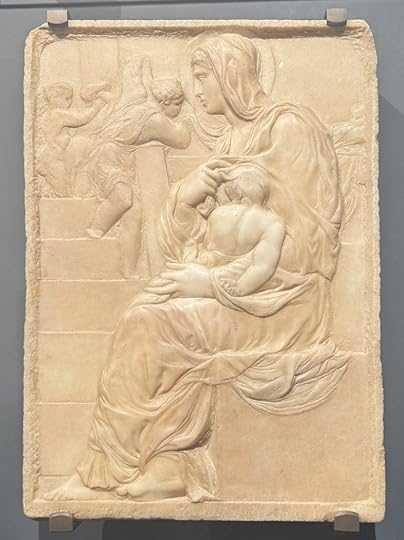

With no-one around, these beautiful Renaissance rooms were a perfect place for a couple more Ceiling Portraits:
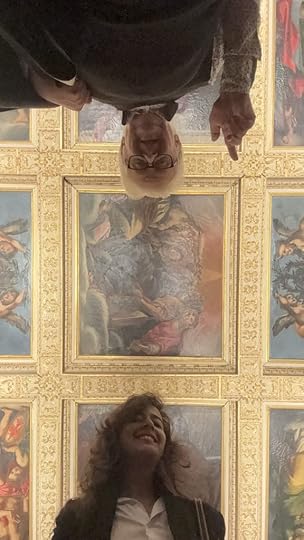

Camila is a perfect travelling companion. She listens attentively while I dredge up factoids, half-remembered from history of art lectures at my art college of sixty years ago.

I found the visit to the Basilica of Santa Croce a very moving experience. The mythical figures of history take on a new reality when you look at their tombs. Here is Galileo, and directly across the nave from him is Michelangelo in a tomb designed by his great friend Vasari. And to the left of him is Dante! (Well, a cenotaph, actually). And so it goes, all these local boys. Here’s Machiavelli and in the Sacristy is Cimabue’s crucifix, (1288) still damaged from the terrible 1966 floods. (I first saw it in 1968 when evidence of flood damage was everywhere.) And finally there is a woman, at the end of the First Cloister is a monument to Florence Nightingale from 1913. Here, in order, Galileo, Michelangelo and Machiavelli.



Even though it was only April, there were already crowds of tourists. In the Uffizi there was a queue for the Tribune, so we joined it, not knowing what it was. It is, of course, the octagonal gallery built by Francesco 1 de’ Medici in 1584, and famously painted by Zoffany. I should have remembered. At the head of the queue we found that you can only look in the door, but it is a wonderful room with a domed ceiling and Grego-Roman statuary arranged around it. In the centre stands the Medici Venus, dating to the end of the second century BC, a marble copy of a bronze Greek original. William Blake’s father bought him a cast of this when he was studying at Henry Pars’ drawing school on the Strand and there is also a cast in the Royal Academy School. She is justly famous, a reference point in the history of Western art. I was pleased to see the original.

Camila enjoyed the Botticelli room. It is filled with his works but the tourists cluster around the two most famous: The Birth of Venus and Primavera. Fortunately the crowds thinned out enough to get a good view of everything there. It’s only when you see the two most famous pictures in reality and can appreciate their size and the luminosity of the painted surface that you can fully understand them. The endless repetition of the images on tea-towels, t-shirts and coffee mugs have reduced their impact to mere branding, but up close you can see why the Pre-Raphaelites loved him so much and copied him so slavishly. We, of course, also took photographs. One of my favourites was another Venus, busy shocking the local prudes, in Calumny of Apelles. We liked the Uffizi. Here we are in the roof terrace café.


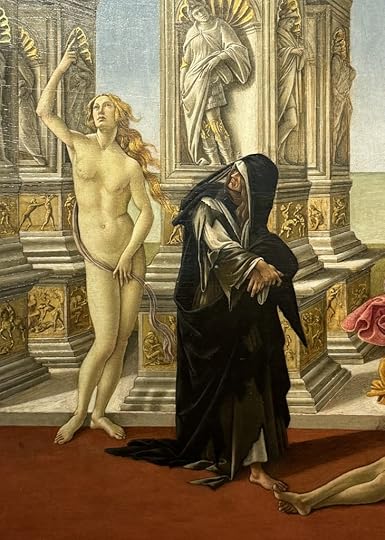

The Museo del Bargello has four Michelangelos, more than anywhere else in Firenze, but it was almost empty. They are a bust of Brutus, a life-size Apollo, the Tondo Pitti, and my favourite, the early, 1496, Bacchus, huge, tipsy if not completely pissed and looking as if he’s about to fall over.

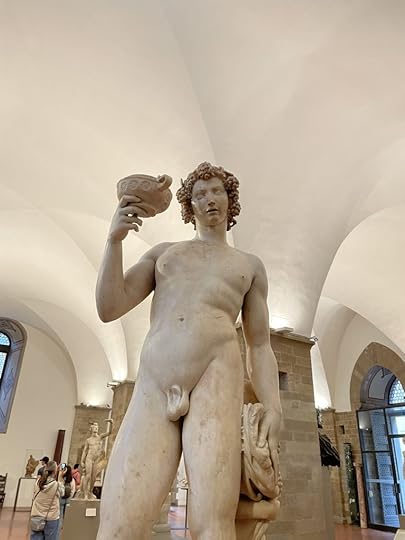

I was expecting to find crowds at Michelangelo’s tombs in the Medici Chapels in San Lorenzo but there were only one or two people there. It was a good photo-op (sorry). The figures are magnificent, Michelangelo twists them uncomfortably to make the stone live. The main chapel is totally over the top as we used to say. The Medici balls are everywhere, and you could spend hours just looking at the variety of coloured marbles. Here we are with Lorenzo, followed by Giuliano’s tomb that faces it across the chapel.

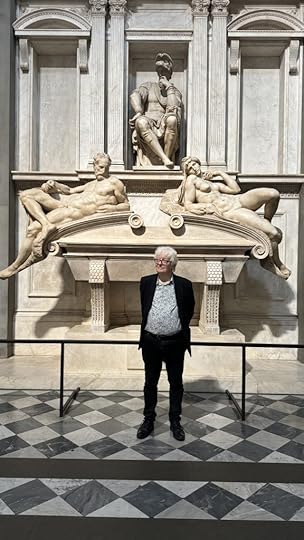
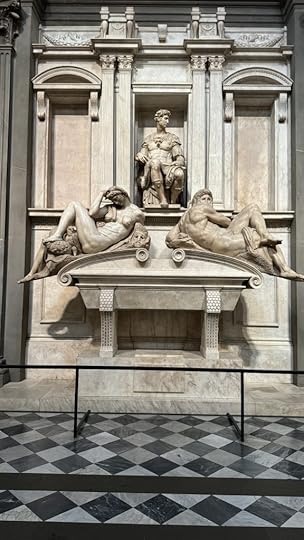

It was not all museums, though as it rained so much, they were a welcome shelter. At the back of the Mercato Nuovo, the 16th century covered market (not worth seeing) there is a bronze boar, Porcellino, whose snout fingers have polished gold. Touching it guarantees your return to Firenze, so Camila will be back. People also put coins in its mouth, which is obviously what the chap sitting next to it is waiting for.
At the Palazzo Vecchio Camila acts her Cabral moment and discovers Brazil. Pedro Álvares Cabral landed in Bahia, her home estado, on 22 April 1500, claiming it as a Portuguese colony. This was a disaster for the Tupinambá and the Tupiniquin whose land it was.
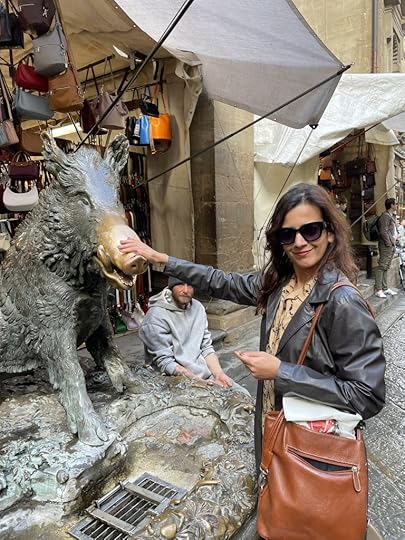

Despite our pointless Florance City passes, we could only get tickets for the Accademia four days hence. They were for 3:00pm. We finally got in at about 4:10. The Accademia has nowhere for people to wait so the street outside was thronged with people and umbrellas. The gallery only allows a certain number of people to enter but, because of the rain, no-one was leaving. (The worst example of this poor planning is the Fondation Vuitton in Paris designed by Frank Gehry and costing $790 million. There is nowhere to wait so in the summer the long lines form outside in the sweltering heat and in the winter, they line up in the cold with umbrellas. I used to admire his architecture, but this building is a piece of egotistical shit. He should give the French State back their money. Over $600 million came from the French taxpayer. Harrumph!) The Accademia was established in 1784 when presumably the numbers of visitors were in the dozens not thousands (1.46 million visitors in 2016).
It is the home of Michelangelo’s David. That’s what they are all there for. It is also home to his four unfinished Prisoners, originally intended for the tomb of Pope Julius II and a statue of Saint Mathhew. But it is David they have all come to see. The slab of marble had already been worked on by two previous sculptors before Michelangelo got it and was also quite shallow, meaning that he had to create a frontal figure without much projection into space. He worked from the front rather than the usual all-round shaping and by getting quite close in towards the final shape he automatically shaped the sides while the back remained very roughly hewn until the end. This method gave him room to improvise rather than working from a pre-ordained idea of the piece. The head is large to allow for perspective when seen from below. The hands are overlarge and expressive. It is quite rightfully regarded as his greatest work. In a nice reversal of the male gaze, we went round the back to have a look at his bottom. There were several young women there, demonstrating the female gaze, and Camila was one of them. He has a nice ass. The prisoners are tremendous: struggling to free themselves from the blocks of marble that encase them. They are wonderful as they are, unfinished.
The museum has a few other works, paintings by Botticelli, Giotto and Lippi and several rooms devoted to a collection of musical instruments including a violin cello and a tenor viola made by Stradivari.



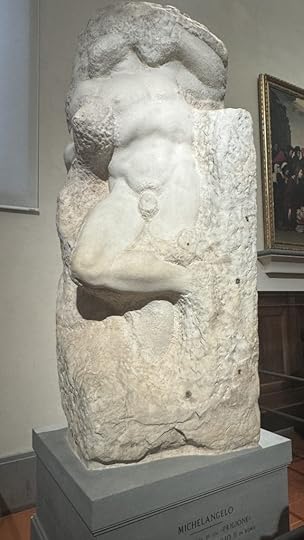

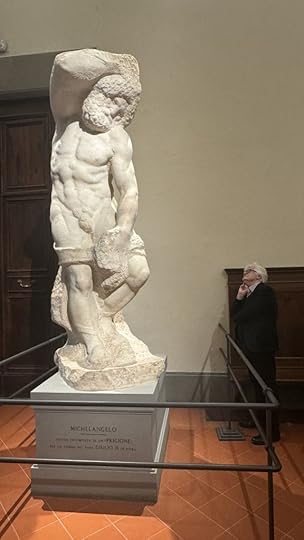


And so to Siena, but first a quick look at Percy Shelley’s gaff which is just across from the station.


To get from the station to the town, you have to go up 10 elevators. It takes ages but it certainly saves walking to the top of the hill. At the top was one of my favourite street signs which presumably means; ‘If you piss here we will cut your balls off!’ In Siena all roads lead to the Piazza del Campo where each year they hold the Palio. Siena seemed a nice town, perhaps a little quiet. Everyone seemed to be a tourist, as if it was a ghost-town with no-one actually living there. Finding lunch was difficult but we managed.
Back to Firenze and then London. No Stendhal Syndrome, which some doctors argue comes from tilting your head back to look upwards so much that it restricts the blood supply to the brain and makes you feel faint. Firenze cannot compare to Venice, but I’d be delighted to visit again, when it’s sunny.

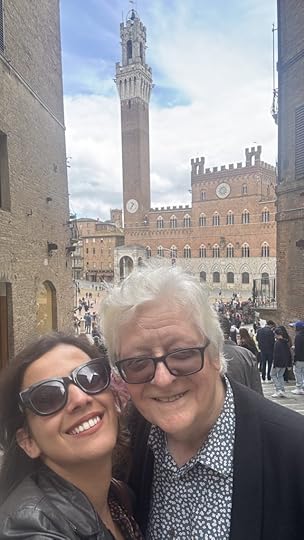
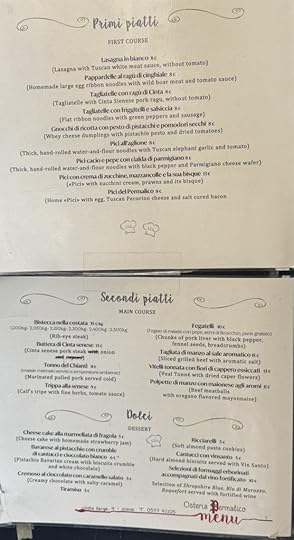


Barry Miles's Blog
- Barry Miles's profile
- 152 followers



